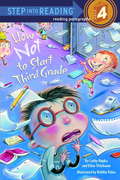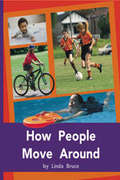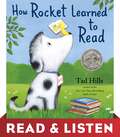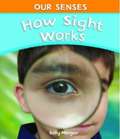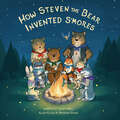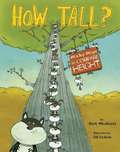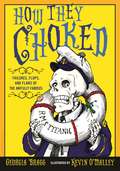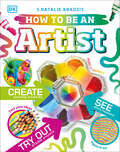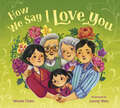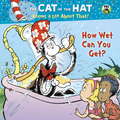- Table View
- List View
How Not to Start Third Grade (Step into Reading)
by Cathy Hapka Debbie Palen Ellen TitlebaumWill should be excited to start third grade. But his little brother, Steve, is starting kindergarten. The same laugh-out-loud writing and hilarious illustrations that brought us How Not to Babysit Your Brother now portray the tribulations and embarrassments of starting school with a very troublesome little brother. School will never be the same!Cathy Hapka and Ellen Titlebaum are the authors of many books for children. This is their second book about Will and Steve. They live in Lincoln University, Pennsylvania, and New York City, respectively.Debbie Palen has illustrated many books for children, including How Not to Babysit Your Brother and the first four books in the Andrew Lost series. She lives in Cleveland, Ohio.
How People Learned to Fly
by Fran HodgkinsIn this book you find out about the many obstacles that have been overcome so planes and people can soar through the sky. <P><P>[This text is listed as an example that meets Common Core Standards in English language arts for K-1 at http://www.corestandards.org.]
How People Move Around (Rigby PM Plus Blue (Levels 9-11), Fountas & Pinnell Select Collections Grade 3 Level Q)
by Linda BruceHow People Move Around by Linda Bruce
How Quetzalcoatl Brought Chocolate to the People: An Aztec Legend (Our World Readers)
by Lynn MeshNIMAC-sourced textbook
How Rocket Learned to Read (Rocket)
by Tad HillsThis sweet picture book starring an irresistible dog named Rocket and his teacher, a little yellow bird, is perfect for back-to-school! Follow along as Rocket masters the alphabet, sounds out words, and finally . . . learns to read all on his own. With a story that makes reading fun-and will even help listeners learn to read-this book is ideal for kindergarten classrooms and story hour or as a gift for that beginning reader. Fresh, charming art by Tad Hills, theNew York Timesbestselling author/illu...
How Rocket Learned to Read: Read & Listen Edition (Rocket)
by Tad HillsLearn to read with this Read & Listen edition of the New York Times bestselling picture book, starring an irresistible dog named Rocket and his teacher, a little yellow bird. Follow along as Rocket masters the alphabet, sounds out words, and finally . . . learns to read all on his own!With a story that makes reading fun—and will even help listeners learn to read—this book is ideal for kindergarten classrooms and story hour or as a gift for that beginning reader. Fresh, charming art by Tad Hills, the New York Times bestselling author-illustrator of Duck & Goose, will make this a favorite.This ebook includes Read & Listen audio narration.
How Sight Works (Our Senses)
by Sally MorganThis book introduces the sense of sight and how it helps us function in everyday life.
How Slow Is a Sloth?: Measure the Rainforest (Nature Numbers)
by Jill EsbaumIn Nature Numbers, math is beautiful, recognizable, and all around us! Highly engaging pictures of animals and nature scenes, along with cool chalk illustrations, are used to introduce basic math concepts and encourage kids to see a world of numbers all around them.K-2 math concepts include measuring. This book explores measuring elements of the rainforest with amazing nature pictures and chalk illustrations!
How Smell Works (Our Senses)
by Sally MorganWhy do some things smell good and other things smell bad? This book explains where our sense of smell comes from and how it helps us function in everyday life. A lively, straightforward narrative presents scientific concepts for young readers and an activity is included enhance the learning experience.
How Steven the Bear Invented S'mores (Steven the Bear)
by Scott HallHow Steven the Bear Invented S’mores is a read aloud picture book with fun life lessons and colorful illustrations. Steven the Bear and his friends are excited to go on their very first camping adventure. After being sure to pack and prepare well, the Bear Bunch heads out to find the perfect campsite. They set up camp and spend their day hiking, bird watching, and finding animals. After a day full of fun, Steven and the Bear Bunch sit down to toast marshmallows. That’s when Steven has a brilliant idea…? Join Steven the Bear and his friends in this first of many adventures!
How Tall?: Wacky Ways To Compare Height (Wacky Comparisons)
by Terry Flaherty Mark Weakland Advocate-Art Staff Igor SinkovecHow many chipmunks equals the height of a redwood tree? Discover this comparison and more in this wacky, laugh-out-loud introduction to height. Quirky illustrations and lyrical text help kids explore measureable attributes of a variety of things in a uniquely engaging way. A perfect read-aloud for young science lovers and budding mathematicians.
How Taste Works (Our Senses)
by Sally MorganIntroduces the sense of taste, including how taste buds work, why the sense is important, and how the sense of taste differs in humans and animals.
How They Choked: Failures, Flops, And Flaws Of The Awfully Famous
by Georgia BraggEveryone makes mistakes. Sometimes, epic failures even lead to super successes . . . sometimes they become deep dark secrets. But remember--to fail is human, to laugh about our shortcomings divine. From Montezuma II's mistaking a conqueror for a god to Isaac Newton turning from science to alchemy to J. Bruce Ismay's jumping the lifeboat line on theTitanic, How They Choked knocks fourteen famous achievers off their pedestals to reveal the human side of history. Successful “failures” include: Marco Polo, Queen Isabella of Spain, Montezuma II, Ferdinand Magellan, Anne Boleyn, Isaac Newton, Benedict Arnold, Susan B. Anthony, George Armstrong Custer, Thomas Alva Edison, Vincent van Gogh, J. Bruce Ismay, “Shoeless Joe” Jackson, Amelia M. Earhart
How Tiger Got His Stripes: A Folktale from Vietnam (Our World Readers)
by Anna OliviaNIMAC-sourced textbook
How To Be A Fashion Designer: Ideas, Projects, and Styling Tips to Help You Become a Fabulous Fashion Designer (Careers for Kids)
by Lesley WareDraw and color creations, choose materials, and learn to design through drawing your own fashion. Whether your child wants to design the next big outfit for New York fashion week, or they just want to learn about textiles and fabrics, How to Be a Fashion Designer helps kids enjoy experimenting with new ideas.Bright illustrations mixed with fun photography show kids how to choose gorgeous colors, design dress shapes, customize t-shirts, and add sparkle to their accessories using simple, easy-to-follow design tasks and practical projects.Using inspiration from the natural world, everyday life, and their own imagination, children can design outfits from scratch and learn how to put together the clothes and accessories they already own in fun, stylish ways. This nonfiction fashion book for children is perfect for 7–9-year-olds and brings a unique approach to STEAM learning by combining art and design with practical, hands-on making.
How To Be An Artist (Careers for Kids)
by DKFall in love with art and design! This creative kids book introduces them to the wonderful world of art history and creating art!Discover the artist that lies within through the pages of this children&’s craft book. More than that, this book encourages art as a STEM field and teaches kids the history of art, art theory, and introduces them to the most notable artists who have influenced art movements. How to be an Artist includes fascinating details on the art world and gives children the opportunity to learn key artistic skills. The book includes: • Step-by-step projects, information about artistic movements, and profiles on pioneering artists • Four sections: drawing, painting, crafting, nature, and animating • Information on the educational importance of including art in STEM learning • Over 30 art activities From amateur to artist in no timeCreate your own masterpieces while you learn to paint, draw, and design. How to be an Artist is an exciting introduction to a lifetime of art appreciation. Author Natalie Abadzis includes over 30 activities to encourage and stimulate even the most reluctant young artist. From basics, such as composition and perspective, to the trickier techniques of illusion and paper engineering, to woodwork, photography, and sculpting, this art activity book for kids gets their creative juices flowing. Plus, introductions to artists such as Frida Kahlo, Albrecht Drurer, and Yayoi Kusama will inspire and excite budding artists!Don&’t let the fun stop - discover others in the seriesThe How to be a series is aimed at young readers ages 7-9. These books introduce them to STEM fields such as science, maths, and now art. These books are fun and engaging and make these subjects a pleasure to learn. Other books in this series include How to be a Scientist and How to be a Maths Whizz.
How To Read A French Fry and Other Stories of Intriguing Kitchen Science: And Other Stories of Intriguing Kitchen Science
by Russ ParsonsWhy can you stick your hand into a 450-degree oven but not into 212-degree boiling water without burning it? Why does fish taste different from meat? Why do you cook pork differently from beef? Why should you always start cooking dried beans in cold water, not warm? Why should you never cook a Vidalia onion? What's the only kind of marinade that&’s really an effective tenderizer? Why is strawberry-rhubarb a good combination, scientifically speaking? And why don&’t potatoes fried in fresh oil ever brown completely, no matter how long they're cooked? &“Cooking is full of questions that science can help you answer, questions that can make you a better cook,&” writes the award-winning Los Angeles Times food editor, Russ Parsons. In this entertaining book packed with fascinating tidbits, Parsons explores the science behind such basic cooking methods as chopping, mixing, frying, roasting, boiling, and baking. You&’ll learn why soaking beans can&’t offset their gaseous effects, why green vegetables shouldn&’t be cooked under a lid for long, which fruits you can buy unripe and which you should buy fully ripened, which thickener to choose for your turkey gravy, and which piecrust is foolproof for a beginner. Along the way, Parsons slips in hundreds of cooking tips, provocative trivia, and touches of wit that make his scientific explanations go down smoothly. He also includes more than a hundred recipes that deliciously exemplify the principles he describes, from Tuscan Potato Chips and Crisp-Skinned Salmon on Creamy Leeks and Cabbage to Chocolate Pots de Creme and Ultimate Strawberry Shortcake.
How To Swallow A Pig: Step-by-step Advice From The Animal Kingdom
by Steve Jenkins Robin PageIn the latest eye-catching escape into the kingdom of Animalia, Steve Jenkins and Robin Page reveal the skills animals use to survive in the wild in an imaginative and humorous how-to format. With step-by-step instructions, readers learn about specific behaviors; how to catch thousands of fish like a humpback whale or how to sew up a nest like a tailorbird. This fascinating and fun illustrated nonfiction melds science, art, biology, and the environment together in a detailed and well-researched book about animals who live and survive in our world today.
How To Talk To Your Cat
by Jean Craighead George Paul Meisel Sue TruesdellFind out what your cat is really saying -- and talk back! What is your cat telling you when he rubs against your leg? What does it mean when he holds his tail straight up? Discover the different kinds of meows and what they mean; find out how to read whiskers, tails, facial expressions -- and much more! Jean Craighead George, award-winning author of over 80 books about nature and animals, demonstrates in words and photos how to communicate with that ever-mysterious, ever-lovable animal -- the cat. Children's Books 2000-NY Public Lib.
How To Train Your Dragon Collection: The First Three Books!
by Cressida CowellCollected together for the first time, read the first three books that inspired the How to Train Your Dragon films: How to Train Your Dragon/ How to Be a Pirate/ How to Speak Dragonese Hiccup Horrendous Haddock the Third is a smallish Viking with a longish name. Hiccup's father is chief of the Hairy Hooligan tribe which means Hiccup is the Heir to the Hairy Hooligan throne - but Hiccup feels like a very ordinary boy. Can he be a Hero?This book bundle contains the first three hilarious stories in Hiccup's adventures with his dragon, Toothless. Will Hiccup lead ten novices in their initiation into the Hairy Hooligan Tribe. Can he steal back his book of Dragonese from the Romans? Can he navigate the Fortress of Sinister, and defeat the Monstrous Strangulator?Most importantly, can Hiccup really save the Isle of Berk with a dragon who looks like an ickle brown bunny with wings? There's only one way to find out...
How To Train Your Dragon: Book 10 (How To Train Your Dragon Ser. #10)
by Cressida CowellRead the HILARIOUS books that inspired the HOW TO TRAIN YOUR DRAGON films! Hiccup Horrendous Haddock the Third is a smallish Viking with a longish name. Hiccup's father is chief of the Hairy Hooligan tribe which means Hiccup is the Hope and the Heir to the Hairy Hooligan throne - but most of the time Hiccup feels like a very ordinary boy, finding it hard to be a Hero. When we last left Hiccup things were getting very dark indeed. The Dragon Rebellion has begun. Snotlout is the new Chief of the Hooligan Tribe. Stoick has been banished and given the Slavemark. And Alvin the Treacherous has EIGHT of the King's Lost Things, and has been proclaimed the new King of the Wilderwest ... But what can Hiccup do, now all alone and in exile, hunted by both humans and dragons? Can he find the Dragon Jewel, mankind's last and only hope and become the Hero once again?***Please note this ebook is TEXT ONLY and does not include the illustrations that appear in the printed book.***READ ALL 12 BOOKS IN THE SERIES!You don't have to read the books in order, but if you want to, this is the right order:1. How to Train Your Dragon2. How to Be a Pirate3. How to Speak Dragonese4. How to Cheat a Dragon's Curse 5. How to Twist a Dragon's Tale6. A Hero's Guide to Deadly Dragons7. How to Ride a Dragon's Storm8. How to Break a Dragon's Heart9. How to Steal a Dragon's Sword10. How to Seize a Dragon's Jewel11. How to Betray a Dragon's Hero12. How to Fight a Dragon's FuryHow to Train Your Dragon is now a major DreamWorks franchise starring Gerard Butler, Cate Blanchett and Jonah Hill and the TV series, Riders of Berk, can be seen on CBeebies and Cartoon Network.
How Touch Works (Our Senses)
by Sally MorganIntroduces the sense of touch, including how the skin's nerve endings function, how touch is important, and how the sense differs between humans and animals. Picture descriptions present.
How Underwear Got Under There: A Brief History
by Regan Dunnick Kathy ShaskanDid you know that warriors at the time of Genghis Khan invented arrow-resistant silk underwear? Or that the recommended age to begin wearing a corset in the late 1800s was four years old? Or that King Tut had a particular fondness for underwear? He was buried with 145 pairs!<P><P> This lively text consists of ten chapters on various aspects of underwear, including the social and historical ramifications of different undergarments and their development for warmth, support, protection, cleanliness, and status. Regan Dunnick’s clever illustrations and Kathy Shaskan's accessible text is giggle-worthy, page-turning, and well-researched. From boxers to bustles to briefs, from history to humor, from support to society, the story of underwear is the story of humanity itself.
How We Say I Love You
by Nicole ChenIn this heartwarming picture book, an Asian American girl shares how her family expresses their love for one another through actions rather than words.How do you tell your family that you love them? For Hana, love is all around her: Mom stirs love into a steaming pot of xifan. Dad cheers with love at her soccer game. Hana says good night with love by rubbing her grandma's feet and pouring her grandpa his sleepy tea. And as the light fades, Hana's parents tuck her into bed and give her a good night kiss. So many families express their love in all they do for one another, every day. Here is a book that wraps you in a hug and invites your family to share their own special ways of showing love.
How Wet Can You Get? (Pictureback(R))
by Joe Mathieu Aristides Ruiz Tish RabeSally and Nick are playing in the rain--and getting really muddy! So when the Cat in the Hat offers to show them how animals get clean, the kids are keen to find out. But can Sally and Nick really get rid of the mud by taking dust baths, like a sparrow? Or by licking themselves, like a lion? And where are they going to find an oxpecker to pick it off them, like a hippo has? (Besides, oxpeckers tickle!) Maybe there's a better way for a kid to get clean? Based on an episode of the new PBS Kids program The Cat in the Hat Knows a Lot About That!, this 16-page Pictureback comes with a sheet of adorable stickers featuring all the mud encrusted characters.
